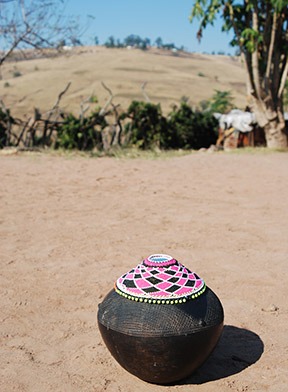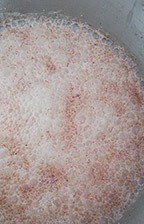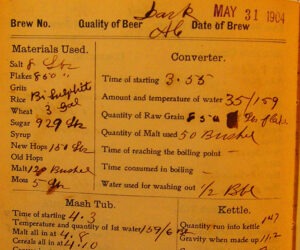A Sip of Tradition

If I asked you to picture a beer, most of your imagined pints would be similar: The beer would be translucent and bright, topped with half an inch or so of foam. Sure the colors might vary — to some, the beer would be golden, to others it would be copper-hued or borderline black. The foam in your mind’s eye could be pillowy and white or dense and beige. If you’re really craving that beer, you might be able to see the bubbles rising, or picture a bead of condensation on the outside of the glass, giving evidence that the liquid within is chilled and ready to refresh.
But if you were a South African drinker attending a traditional ceremony or visiting a rural homestead, the beer in your head would be very different indeed. It would be completely opaque and of a color you might even struggle to describe — a greyish, pinkish shade that certainly doesn’t feature on Beer Judge Certification Program color charts or Lovibond lists. On a good batch there would be foam, but made up of great big bubbles, the sort you might expect when a kid blows into a glass of milk with their straw. You actually wouldn’t see much more than these bubbles, since the beer is never served in glass, but in a communal pot, usually made of clay. This is umqombothi, and it has more in common with the beer of hieroglyphics than the beer in your fridge.
The history of umqombothi is sadly unwritten, but the traditional brew is thought to date back millennia. In South Africa it goes by many names, thanks to the country’s many languages, but the isiXhosa word umqombothi (the “q” is pronounced as a click — imagine you’re imitating horses’ hooves or a popping cork and you’ll be close) is the most widely used. The beverage also has a more informative moniker — it is often referred to as sorghum beer.
An Endangered Style
Historically, the grain bill would have featured sorghum alone. A member of the grass family, sorghum has long been domesticated in southern Africa and is used as cattle feed, a food crop, and of course, in beer. These days, pretty much all umqombothi recipes include crushed maize alongside malted sorghum. Maize probably made its way to southern Africa with Portuguese colonizers in the 16th or 17th century and at some point afterwards also made its way into traditional brew pots. It gives a slightly lighter brew, both in color and in body, and different brewers will use it in varying quantities depending in part on personal preference but more so on the recipe that has been passed down through the generations.
In recent years, the consumption of traditional sorghum beer has fallen out of favor and some fear for its future. Often considered a beverage for old folks, or associated with rural living, younger drinkers tend to overlook it in favor of what is known in South Africa as “clear beer” (umqombothi falling in the category of opaque beer). A couple of commercial breweries produce sorghum beer on a large scale, but it was always principally a beverage produced at home and that remains true to this day.
As is the case with historical brewing across much of the world, umqombothi was traditionally brewed by women, and this too remains much the same today. In some rural areas, women will brew the beer to sell, and just as a craft beer enthusiast will queue for the latest release from their favorite brewery, so will umqombothi enthusiasts flock to the home of their favorite brewster when the flag flies to show that a fresh batch is for sale.
Mostly though, the beer is brewed for special occasions such as weddings, coming-of-age ceremonies, and to give thanks to the ancestors. Happily, in the past couple of years, South Africa’s craft brewers have also begun to show interest in their beer heritage and have started to work out ways to incorporate it into their lineups, albeit usually in a modernized manner.
My first meeting with a bucket of umqombothi came almost 20 years ago, long before I ditched my native United Kingdom in favor of living at the southern tip of Africa. I won’t lie and tell you I fell in love with this little piece of beer history on first sip. It was all I could do to swallow a mouthful of the weird, utterly unfamiliar liquid as the communal bucket was passed around my group of fellow backpackers. It had nothing at all in common with any beer I had tasted up to that point.
Umqombothi is thick, and not just that, it is gritty. It has a consistency similar to that of pouring cream, and despite rudimentary lautering, there are plenty of small grain particles still in suspension. The aroma would not be entirely unfamiliar to a lover of lambic or Brettanomyces beer, but that barnyard funk was quite a stretch for a 20-something backpacker. On sipping you get a distinct lactic sourness, with background notes of cooked grain and some fruitiness — flavors of green apple and cooked strawberry are often picked up. I feel that the term “acquired taste” is appropriate here. I have lived in Africa for almost a decade and despite having tasted it on many occasions, it was only last year that I willingly went back for second and third sips of traditional sorghum beer.
The Original Sour?
The sourness comes from the fact that the beer — like all ancient styles — is fermented spontaneously. In fact, pretty much everything about the brewing process is still done as it would have been hundreds of years ago. Before you begin your brew, you can put away your refractometer, hydrometer, and even your thermometer. You won’t need any of them here. There’s no need to tweak the water or calculate IBUs — umqombothi far predates the use of hops in beer and remains unhopped to this day.
One thing you will need in order to approach the style though, is time. Brewing the beer is a fairly involved five to six day process. And then you need to be ready to drink it — or to invite over a bunch of beer buddies to come and drink it with you. Umqombothi is consumed young — indeed, it is best sipped while it is still fermenting.
Following the awakening that I could actually rather enjoy umqombothi, and with that a deep interest in the beer’s link to the very origins of brewing, I decided it was time to try and brew a batch. I challenged our local homebrewing club to join in, and earlier this year we hosted a traditional African beer contest — the first in the Cape Town club’s almost 20-year history.
In South Africa, sorghum malt is easily found in supermarkets and comes ready crushed. It also comes with a handy, easy-to-follow recipe on the packet, though for our recipe we turned to a seasoned hand for some tips. Nolu Roxwana-Matiwane is the Co-Owner of Cape Town craft brewery Ukhamba Beerworx, but she has also brewed traditional beer throughout her life, learning, as most brewsters do, from the women in her family.
How It’s Made
Things appear to kick off much as they would in any brew — with the mash. But although you’re mixing grains and hot water, the goal here isn’t to convert starches to sugars. The first stage of the process has two aims— to begin the gelatinization process and to encourage the production of lactic acid. So as per Nolu’s recipe, I mixed the malted sorghum and maize with hot water, then added the designated amount of cold water to reach the right mash temperature (known by the not-so-technical term, “warm”). On Nolu’s suggestion that a fabric covering is better than a plastic lid, I clipped a tea towel over the top of the bucket and left it in the bathtub to cool overnight. As it cools, the Lactobacillus found on the grain produces the lactic acid that gives umqombothi its characteristic tang.
I awoke on day two to find a few bubbles lazily rising to the surface, along with a distinct aroma. It was at this moment that our club WhatsApp group started to wake up. Brewing traditional beer was a first for us all and we were anxious and unsure at each stage of the process. The prolific chat was filled with photos captioned “does this look right?” and messages asking “is it meant to smell like this?!” A lactic sourness is of course to be expected, but our homebrewing group also noted cheesy and barnyard-like aromas, all of which ultimately seemed appropriate.
On the second day, some brewers remove a cup or two of the liquid and set it aside to restart fermentation later. Others get straight to the boil. At this juncture I need to warn you of something — boiling a pot of soured sorghum and maize porridge does not smell good. The WhatsApp group was again alive with commentary as our respective pots hit the stove. Children were removing themselves to their bedrooms, complaining of aromas akin to vomit; some brewers were locked in their kitchens by unhappy spouses and one was given an ultimatum — take the brew outside or else find somewhere else to live. Even our mentor, Nolu, admitted the aroma on boil day is enough to send her daughter into the yard to take a breather. Perhaps that’s why it’s traditionally cooked on a fire outside the home.
There are no hops to isomerize, but the boil still serves three important roles: First, it helps to drive off volatiles that you don’t want in the final product. That smell wafting through your kitchen as you boil might be pretty bad, but if those aromas and related flavors made their way into your beer, they would render it undrinkable. Second, the boil kills off the Lactobacillus, ensuring that your beer isn’t unmanageably sour. And finally, the boil helps finish off the gelatinization process. Sorghum malt has a harder husk than barley malt so first you need to soften the grain to allow the enzymes to convert starches to sugars. While you’re boiling, keep your eyes peeled for bees — traditional brewing lore sees them as a good omen and a sign that your brew will be a successful one.
After an hour on the stove, you’ll be left with a thick porridge, known as umhiqo. Traditionally, a few bowls of this are scooped off and served with a sprinkling of sugar. It’s the only part of the process that involves children in any way as they sneak back in and devour a bowl of the strangely sweet and sour mixture. This too is perhaps a flavor that not everyone loves on first bite. Friends who grew up around traditional brewing have the fondest memories of wolfing down a bowl of umhiqo, much in the same way some grown-ups are nostalgic for certain types of breakfast cereal. I sneak a spoonful and while I can understand how it would fill and warm a tummy, I’m not sure I could manage to finish a bowl. It’s now time to cool, but there’s no need for counterflow chillers or even a bathtub full of ice — just transfer the porridge to your bucket and let it cool overnight.
With gelatinization complete, the conversion of starch to sugar can at last take place. It’s kind of fascinating that mashing and fermentation happen simultaneously on day three. You need to restart fermentation with a helping of malted sorghum and in some recipes, a handful of maize. This is also the moment to add back that wort you removed before the boil, if you opted for that step. For me, it was also time to add more water, as there was so little liquid in my clump of cooled porridge, even the most powerful ancient drinking straw couldn’t have sucked up anything from the bottom of the pot. Unable to contact Nolu, I employed the ancient art of guesswork, adding water until I felt it had reached the right consistency.
Just like any other beer style, recipes for the beer vary from family-to-family, village-to-village, and country-to-country. Some brewers choose to add sugar at this point, or sometimes yeast. Both would of course help raise the alcohol content and ensure a more vigorous fermentation, though neither is strictly traditional. I stuck with a 100% spontaneous fermentation and began the torturous wait for evidence I had done things right.
Depending on the ambient temperature, fermentation could take from 24 to 48 hours. Expect a range of pungent aromas, a kind of cheesy funk among them. About 36 hours after fermentation began — day five of the whole process — I decided to go ahead and lauter. In a traditional brew, this would include a highly photogenic strainer made of dried grass. In my approximation it featured a colander, a sieve, and in lieu of cheesecloth, an old — but clean — t-shirt.
While some believe that umqombothi should be left in its traditional state, there are local champions of the beer who think that modernizing it might help save it from extinction. One way to widen its appeal is to offer flavored versions, so our club of homebrewers harnessed their creativity and decided to experiment. Some opted for hops, some used ginger, and one particularly successful batch had an addition of Amarula, a locally-produced cream-based liquor akin to Baileys. I had a passion fruit plant dropping fruit all over my back garden and felt the slight sourness of the pulp would work well with umqombothi’s flavors. After straining I split my batch into three: To the first I added a pound (0.45 kg) of fresh passion fruit flesh; batch two would get its passion fruit shortly before serving, while the third portion was to be a straight-up, traditional version.
Drinking Rituals

If all has gone well, your fully-fermented brew should be topped with a creamy, frothy foam. In lieu of gravity readings, some traditional brewsters employ the match method, where a match is lit close to the fermentation vessel. If it quickly blows out, it suggests copious amount of carbon dioxide are blowing off the brew and the beer is ready to drink.
Typically, the beer is served at the source in a communal vessel most commonly called an ukhamba. A little beer is first poured on the ground in homage to the ancestors and then the brewer takes the first sip. Drinkers sit in a circle and either drink while seated, or else they take a knee before taking a sip. It’s considered bad manners to drink umqombothi while standing, and hats must be removed when drinking — at least in a traditional setting. The bubbles are gently blown back and a sip — or gulp if it’s good — is taken before the ukhamba is passed from drinker-to-drinker.
Umqombothi is still packaged for sale by the one or two remaining large-scale producers, but as an actively fermenting product, it is never bottled. Instead it is served in liter-cartons, the likes of which you would instantly associate with milk. The cartons come equipped with a specially designed vent to allow CO2 to escape, and with it, a small amount of the beer, which then dries onto the carton. While the initiate might search for a clean container, the seasoned sorghum beer drinker knows that some beer leaking from the vent suggests a better brew within — a little more sourness, a little more complexity, and a little more kick. Umqombothi is low in alcohol, typically between 2% and 4% ABV, although commercial cartons add a +/-0.5% disclaimer as they can’t guarantee the exact alcohol content.
If you choose to package and transport your brew, opt for a plastic bottle, leave plenty of headspace, and leave the lid only partially tightened. In the time it took me to drive to the homebrew meetup, my bottles had become dangerously pressurized and it required the help of a seasoned umqombothi drinker to open them without spraying the bar with beer.
That evening, the meeting was held at the brewery of Nolu and her husband, Lethu: Ukhamba Beerworx, named in reverence to the traditional drinking vessel. But instead of the communal clay pot, we sipped our attempts at umqombothi from Champagne flutes provided by a beaming Lethu. And suddenly the beer didn’t seem quite so unfamiliar. We had mashed, we had boiled, we had cooled, and fermented, albeit not in quite the usual order. And now we were holding our glasses up to the light, inhaling and sipping, critiquing and comparing notes, just like at any other club competition.
A lockdown Brew (sidebar)
It was one of the strictest lockdowns in the world. South Africans couldn’t leave their homes to exercise, restaurants couldn’t even offer a delivery service, and the sale of alcohol and tobacco was outright banned. So people did what they always do when the purchase of alcohol is prohibited — they made their own.
With homebrew shops initially shut down, people headed to the only places open: Grocery stores. Here they stocked up on fruits and yeast to dabble in various ciders, and of course, maize and sorghum — the ingredients for umqombothi. Eventually, even yeast was pulled from the shelves but luckily, traditional beer requires no additional yeast and it briefly became the darling of thirsty South Africans.
Umqombothi is an endangered species. Although city-dwelling professionals regularly return to their rural homes for celebrations and might be around to take a ceremonial sip of traditional beer, they’re unlikely to arrive home early enough to participate in the days-long brewing process. But in the early days of lockdown, news sites were filled with photos of people around the country loading up flat-bed trolleys with giant sacks of malted sorghum.
Homebrew forums also started to discuss the umqombothi process, and as people’s malt stocks gradually depleted, many long-time brewers attempted their first ever batch of traditional beer. As homebrew stores reopened, followed a few weeks later by liquor stores, the rush on buying malted sorghum slowed. But if one positive thing has come from the country’s draconian lockdown, it is that people who had never before brewed or even tasted umqombothi now understand, and hopefully appreciate, the process and the flavors.
Traditional Umqombothi
(~2.5 gallons/10 L, all-grain)
ABV = ~2.5%
Recipes for umqombothi vary wildly. Some use double the amount of sorghum-to-maize, others use more maize than sorghum. Some start with a vast amount of liquid while others add the liquid in stages as the days progress. This recipe is based on one given to me by Nolu but with a few of my own tweaks that came about when I wasn’t sure what to do next and couldn’t get hold of my mentor. The recipe (with some added passion fruit) went on to win the homebrewing competition, which was judged by drinkers that were extremely familiar with the style.
Ingredients
8.8 lbs. (4 kg) malted sorghum
4.4 lbs. (2 kg) maize meal
Step by Step


Day one
Pour 2 gallons (8 L) of boiling water into a sanitized bucket, then add all of the maize meal and 4.4 lbs. (2 kg) of the malted sorghum to the water. Stir well to ensure there are no dough balls. Place a lid on the bucket for 10 minutes. After 10 minutes, add 1 gallon (4 L) of water. Mix again, then cover with cheesecloth or a tea towel and leave to cool overnight.

Day two
You should see lots of small bubbles rising to the surface of the mash. If you can’t, leave it for a few more hours. You will also note a decidedly sour aroma.
In a large pot, boil 1 gallon (4 L) of water. Once it reaches boiling point, add your sour mash, stirring constantly. Cook for one hour. Timing isn’t as important as you might be used to and you can start the timer from the moment the pot hits the stove — no need to wait until it reaches a boil. The mixture will darken as it cooks.
Stir occasionally to help stop it from sticking to the bottom of the pan, although some scorched grain is inevitable and an acceptable part of the process. After about an hour, return the mixture to your bucket and again leave it to cool overnight. You will find that the mixture is very thick, with little liquid.

Day three
Add the remaining 4.4 lbs. (2 kg) of malted sorghum to the cooled porridge. The mixture will be incredibly thick, with a consistency of mashed potatoes. Add a further 2 quarts (2 L) of cold water and stir. You want the mixture to reach a consistency of runny oatmeal. You might have to add up to 3 gallons (12 L) of extra water, depending on how much the porridge gelatinized during the boil.
Cover and leave in a warm place to ferment overnight.

Day four
You should see plenty of fermentation action, with bubbles rising to the surface throughout the day. If you have visible fermentation, you can strain the mixture and leave the wort to continue fermenting overnight. If fermentation is slow, leave it for another day, pushing the rest of the process back a day.

Day five
If you have strained your mixture, you should see a healthy kräusen atop your liquid, made up of large, cream-colored bubbles. This indicates that it is time to serve. Umqombothi is served uncarbonated and usually unchilled.



